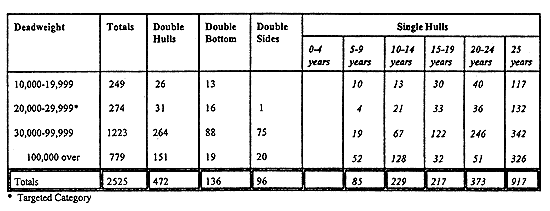ANNEX 8
INITIAL ASSESSMENT OF THE JAPANESE PROPOSAL TO MAKE EXISTING
OIL
TANKBRS BETWEEN 20,000 AND 30,000 TONS DEADWEIGHT CARRYING
PERSISTENT PRODUCT OIL TO BE SUBJECT TO THE SAME CONSTRUCTION
REQUIREMENTS AS
CRUDE OIL TANKERS
1 The Sub-Committee recalled that, at MEPC 41, while
several Member Governments had expressed concern on the scope
of the proposed work programme item, implications to the
shipping industry and the burden for Administrations, a clear
majority of delegations who spoke supported the Japanese
proposal and considered that the Japanese submission meets
the provisions of the Committee's guidelines relating to the
new work programme items, and that consequently the Committee
agreed to instruct the BLG Sub-Committee to carry out an
initial assessment of the Japanese proposal contained in
document MEPC 41/1 8/1 and report to MEPC 42 for further
consideration, taking into account the information provided
by INTERTANKO.
2 The Sub-Committee noted the information provided by
INTERTANKO (BLG 3/13/1 and BLG 3/INF.10) as follows:
1 according to Clarkson's Quarterly Ships
Register, October 1997, and taking also into account the
information provided in document MEPC 41/INF.(Japan), the
world tanker fleet is as follows:
AGE PROFILE OF EXISTING FLEET IN YEAR 2003
(NO ADDITIONS OR SCRAPPING)

.2 according to the above table, there are
currently some 226 single-hull tankers of the targeted
category engaged in the carriage of crude oil and refined
petroleum products (persistent and non-persistent). There is
no clear distinction for the percentage of this population
engaged in the carriage of persistent oil products, In
addition, out of these 226 tankers, some 132 are over 25
years old. Accordingly, there are some 94 tankers in the
targeted category which are below 25 years of age.
3 The delegation of Japan stated that only a small
percentage of tankers of the size in question are affected by
the Japanese proposal (BLG 3/13) and that its proposal is
intended to rectify minor deficiencies in MARPOL regulation
I/13G and would not aggravate to any significant extent the
overall economic impact resulting from the introduction of
the scheme for improvement of oil tanker construction
envisaged under MARPOL regulations I/13F and I/13G.
4 The Sub-Committee agreed that there would be a
limited number of tankers within the targeted size category,
probably less than half a percent of the entire tanker fleet
and even less than that in tonnage terms, and that the
economic burden on industry would thus be limited. In this
context it was also noted that the environmental benefit of
this amendment would be limited. It was also realized that
the economic burden for the individual shipowner could be
significant however the cost of clean-up for persistent oil
could also be significant.
5 The Sub-Committee, however, recognized that oil
pollution incidents involving persistent oils are as severe
as those involving crude oil.
6 The Sub-Committee recognized that the adoption of
amendments to MARPOL regulation I/13G could lead to possible
amendments to the Supplement to IOPP Certificate, which
reflect the two different modes of operation of product
carrier (one carrying persistent oil and the other carrying
non-persistent oil), and agreed to bring this matter to the
attention of MEPC 42.
7 The Sub-Committee agreed that if the MEPC agrees in
principle with the revised Japanese proposal, the MEPC is
invited to use the draft text of amendments to regulation 13G
of Annex I of MARPOL 73/78, as set out at annex, as a basis
for consideration. With regard to the application date of
amendments, the Sub-Committee agreed that if the Japanese
proposal would be adopted, the expected date for enforcement
would be [two years after the date of entry into force of
amendments], i.e. [2003 or after], taking into account the
information contained in the table under paragraph 2 above.
Action requested of the Committee
8 The Committee is invited to note the initial
assessment described above and take action as appropriate.